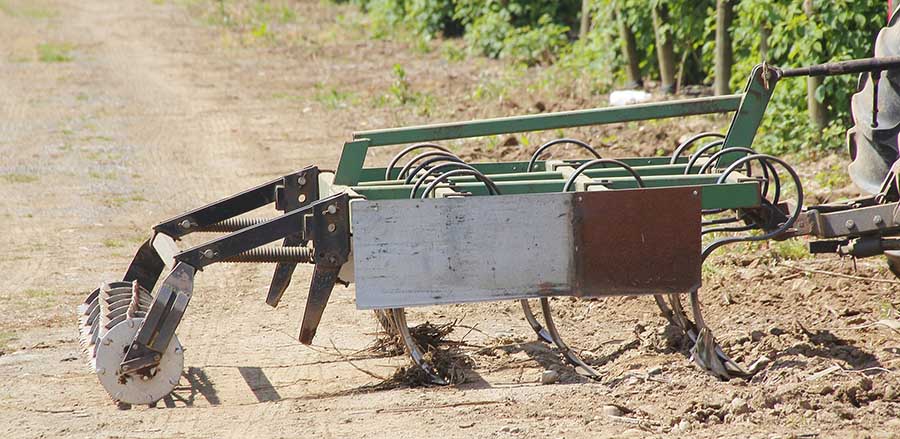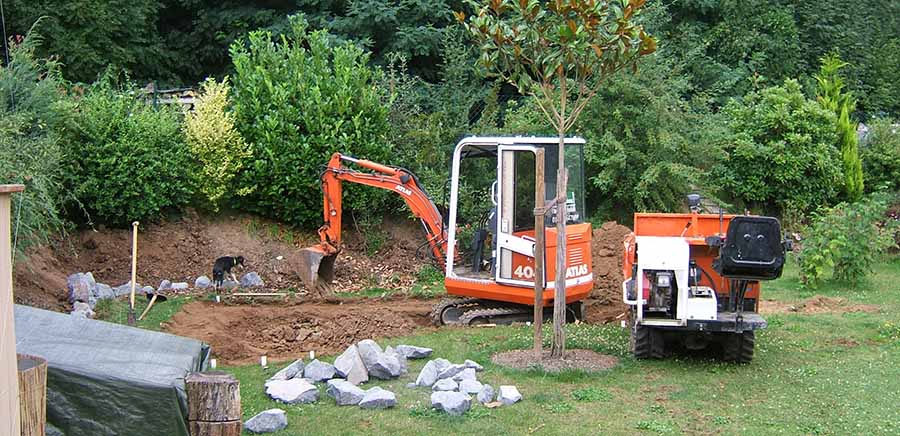Digging a pond can be a rewarding project, but doing it by hand can mean facing weeks with a sore back. Using power equipment such as a front-end loader can make all the difference. It can turn your pond dig into a fun weekend project, completing the job with ease.
Whether you’re building a tiny pond on your property or a relatively larger one on your farmland, there are many benefits to having a pond. It can be visually appealing in a backyard.
For a farm, a pond can sustain a population of fish and be a source of fertilizer. More importantly, it creates an ecosystem that reduces the population of pests and benefits the surrounding wildlife.
Front-end loader buckets can be used to dig a pond. They come as small as 48” wide for a capacity of 13.9 cubic feet of material (heaped SAE rating). They may also be as wide as 108” for a capacity of 32.3 cubic feet (heaped SAE rating), or wider for larger machines.
Whatever your reasons may be for wanting to build a pond, it is essential to know your equipment before embarking on the project. With this knowledge, you can make the right decision as to which vehicle you must use or if it would be more cost-efficient to hire a landscaping company.

Can You Dig A Pond With A Front Loader?
Front end loaders are useful for construction and site-cleaning purposes. The term refers to a scoop attached at the front of a vehicle via a hydraulic-operated arm. Since the vehicle is built for digging dirt, scooping gravel, and clearing debris, it is capable of digging a pond.
However, whether it is the best option depends on the pond’s size versus the equipment’s size. Front-end loaders can come in a variety of sizes and drive types as well.
When you plan to build a pond, it is essential to see all the options that you have at hand, including a box blade and a mini excavator, for example. Moreover, you can use multiple types of power equipment together to get the best results with minimal wear-and-tear.
To decide the best power equipment to use, you must be clear on the size of the project in terms of surface area as well as depth.
For pond sizes up to one-eighth of an acre, you can use a front end loader. That said, digging is only the first step in constructing a pond. Transporting the clay or the sand is next, and it is harder. You should find a dump site and move the dirt there because a pond with a mountain of dirt sitting right beside it is not necessarily a good idea.
Front-End Loader Bucket Types
There are a number of different types of power equipment that can use a front-end loader style bucket and hydraulic arm. From the small skid steers to larger tractors to industrial-sized dedicated front-end loaders, the principles are all the same: An arm that moves up and down and tilts a connected bucket attached at the front.
For most residential and even many commercial projects, a small skid-steer loader is the ideal and readily available power equipment. This equipment can easily be rented from a construction equipment rental company such as United Rentals.
There is a multitude of different variations to buckets. Some are deep, some shallow, some have digging ‘teeth’ while others are shaped differently to be useful for specific tasks. For pond digging, a general-purpose bucket is all that is required.
Compact Utility Bucket Sizes For Small SkidSteer
| Inside Width | Outside Width | Depth | Height | Struck Capacity (CU. FT.) | SAE Heaped Capacity(CU. FT.) |
| 42” | 43” | 23” | 18” | 4.9 | 6.1 |
| 48” | 49” | 23” | 18” | 5.7 | 7.2 |
| 54” | 55” | 23” | 18” | 6.4 | 8.1 |
| 60” | 61” | 23” | 18” | 7.1 | 9.0 |
| 66” | 67” | 23” | 18” | 7.8 | 10 |
| 72” | 73” | 23” | 18” | 8.5 | 10.9 |
When using a front end loader to dig a pond, you should calculate the time required to complete the project. A front loader can generally carry around thirteen hundred pounds of dirt. Any more could pin the scoop or, even worse, tip over the vehicle.
The size of the equipment chosen will determine the bucket size and capacity. It should be relative to the size of the project and the timeline for completion.
Each scoop should be within your vehicle’s capacity and should not be driven too far. Ideally, a dump truck or a pickup would be nearby so that the loader can dispose of the dirt in one place. The transport vehicle can then take away a more considerable amount of the earth, sand, or clay to a predetermined safe disposal site.
Can You Dig A Pond With A Box Blade?
A box blade is an implement often attached to tractors. The blade is pulled by a moving vehicle, and it either collects dirt while leveling the land or contours the land with scarifiers that are usually attached to the box.

Box blades can dig across a large surface, but their capacity for depth of digging is low. Therefore, it is technically possible for a box blade to excavate a deep enough area for a pond, but it requires too many passes, which would bring about an unsustainable amount of wear-and-tear on the equipment.
You may hire a landscaping specialist to dig your pond with a box blade because they already take into account the wear-and-tear, and they constantly replace their equipment. But it isn’t likely to find a company willing to sacrifice their time when they could use more effective equipment.
On the other hand, if you want to use your box blade to dig a pond, you must be aware of the effects that the high-intensity project may have on your vehicle. One way to use a box blade for your pond’s construction while minimizing your vehicle’s damage is by using it in conjunction with a front end loader. A section of this article addresses using a variety of heavy equipment together for pond-building.
Can You Use A Mini Excavator To Dig A Pond?
The mini-excavator (also known as a compact excavator) is a vehicle with a backfill blade that can typically dig up to ten-foot-deep holes. That is why a mini-excavator is ideal for digging a small pond. Since the vehicle is usually tracked, it can also assist in leveling the areas surrounding the pond so that you can shape the pond bank with hand tools.

In addition to digging for depth with a mini excavator, you can perform a large number of scoops without the machine taking an excessively negative impact. A small pickup truck or similar would be a great supplement to this project so that as the excavator digs the dirt, it gets offloaded onto the vehicle. The vehicle can then dump all the dirt at a different location and save you a lot of time in the process.
Five Tips For Digging A Pond With Power Equipment.
The term ‘power equipment’ refers to non-manual tools and can range from an electric drill to a bulldozer. This article’s area of focus is set around excavators. Here are five tips to help you get the most out of digging a pond with power equipment:
Use Multiple Pieces Of Equipment In Conjunction.
Using multiple pieces of equipment will reduce equipment-fatigue and save time. Generally, the tools suited to break the soil are not ideal for digging at depth. On the other hand, the excavators with the best load capacity for depth-digging may sustain damage if used to break clay and compacted soil.
And in almost all instances, a dump truck or a pickup (depending on the pond size) will be required to take the dirt off-site.
It is not necessary to own all the equipment that you are using for the project. You can rent the machinery that you do not own as long as you can operate it. You also have the option to retain the services of a professional landscaping company.
Know Your Pond.
The sort of project largely determines the kind of equipment that is right for it. You do not want to limit the vision you have for your pond by the type of equipment you can access.
So, it is recommended to first decide the kind of pond you want. Is it a home pond? If that is the case, then you are better off using a mini-excavator. On the other hand, a front end loader is better suited for a larger pond with a deeper area.
Use Equipment That Facilitates Depth.
Depth is one of the key factors that contribute to a pond’s sustainability. That is why you should not use power equipment that cannot dig deep enough for the area of the pond you plan to dig.
A front end loader with a smaller load capacity will require too many scoops to dig deep while simultaneously being cost-efficient.
A box blade will help break the soil for a large surface area but may leave the ditch too shallow with the risk of the pond turning into a marsh.
Therefore, it makes sense to use a box blade in conjunction with a front end loader, or a manual hoe together with a mini excavator.
Do Not Try To Do Too Much In One Pass.
Regardless of the equipment that you’re using, do not try to scoop too much in each try. You may risk the bucket getting pinned and the equipment becoming immobile.
If you are using a front end loader, a backhoe excavator, or a non-tracked mini-excavator, the vehicle can tip over, especially if the bucket is lifted too high.
The digging process is time-consuming, and it helps to calculate the time it will take so that you are mentally prepared and do not try to do too much too quickly.
Since it will require multiple passes and a significant amount of driving to build your pond, you should aim to minimize the wear-and-tear caused by each dig and each kilometer driven. One of the ways you can do that is to make sure that there is not an uneven pressure on the vehicle’s front end scoops by keeping the tire-pressure even.
Don’t Order Late Stage Supplies Until Finished Digging.
Because the process of digging with power equipment will introduce obstacles and need improvising, the size and depth of your pond are likely to be different at the end compared to the vision at the beginning.
That is why it is crucial not to order tubing and pond liner before you have finished digging. Once the excavation process is finished, you will have the specifics to purchase customized tubing and pond liner.
Pond Digging Summarized
To summarize, if you know the kind of pond you want to build, you will have no issues deciding on the right equipment. Your options are to use a front end loader or a mini-excavator.
And if it’s a larger farmland pond project, and you’re willing to spend a significant amount of time on it, then you can use a box blade in conjunction with a front end loader. That way, you will be able to cover a larger area and go deep enough to build a sustainable pond (as opposed to a marsh). With this information, you have a great starting point. However, it is highly recommended to get in touch with local landscaping experts. Whether they are helping in a consulting capacity or are digging the pond for you, having professionals on the project makes it more risk-free and cost-effective.

